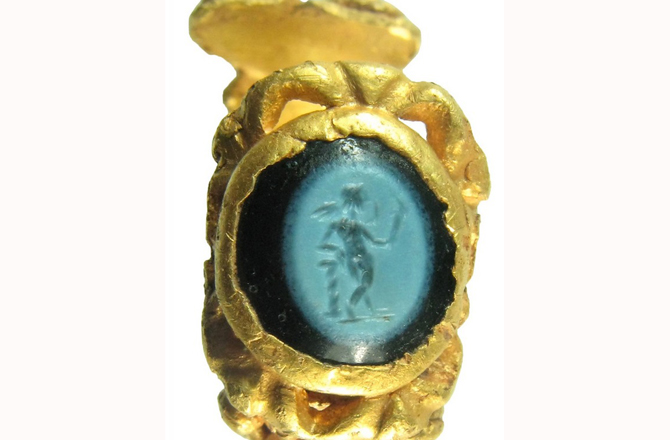An intricately carved gold ring containing a stone engraved with an image of Cupid — a god associated with erotic love — has been discovered near the village of Tangley in the United Kingdom.

would've been worn on the finger of a man or woman at a time when
the Roman Empire controlled England [Credit: © K. Hinds and
Hampshire Cultural Trust]
In the engraving, Cupid (also known by his Greek name, “Eros”) is shown standing completely nude while holding a torch with one hand. The ring dates back around 1,700 years, to a time when the Roman Empire controlled England. The ring was discovered by an amateur metal detectorist. Researchers who studied it say that it may have been worn by a man or a woman and is engraved with spiral designs that contain bead-shaped spheres.
The image of Cupid is engraved on a stone made of nicolo, a type of onyx that is dark at the base and bluish at the top. The image on the stone “depicts a standing naked adolescent with crossed legs, leaning on a short spiral column; the short wings which sprout from his shoulders identify him as Cupid,” Sally Worrell, national finds adviser with the Portable Antiquities Scheme, and John Pearce, senior lecturer in archaeology at King’s College London, wrote in an article published recently in the journal Britannia.
Cupid is shown resting one arm on a column while he holds a torch with the other, Worrell and Pearce wrote. Artistic depictions of Cupid were popular among the Greeks and Romans, and several other finger rings that have stones depicting Cupid are known to exist, the researchers noted. The design of this particular ring indicates that it was created around the fourth century A.D., they said.
A person using a metal detector discovered the ring in December 2013 and reported the finding to the Portable Antiquities Scheme, which was established in 1997 to encourage people to voluntarily report the discovery of artifacts.
In England and Wales, amateurs are allowed to use metal detectors to search for antiquities if they have permission from the landowner and if they avoid archaeological sites that have been granted protection by the government. Certain finds (such as those made of precious metal) must be reported to antiquities authorities.
Worrell said that Hampshire Museums Service has acquired the ring, which will be put on display at the Andover Museum in Andover, U.K.
Author: Owen Jarus | Source: Discovery News [November 26, 2015]










